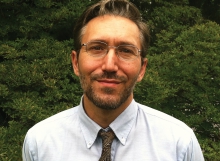
Transformation
For decades, I have wrestled with statements in our parsha. Now, I’m finally ready to let to take a side. Yet, in the end, it may not make much difference.
This week’s Torah reading was from the last two parshiyot in the book of Exodus, Vayakhel and Pekudei. They conclude with the erection of the Tabernacle in the desert:
“When Moses had finished the work, the cloud covered the Meeting Tent and the Presence of God filled the Tabernacle. Moses could not enter the Meeting Tent because the cloud had settled upon it, and the Presence of God filled the Tabernacle.”
The idea of the Tabernacle was communion:
וְעָ֥שׂוּ לִ֖י מִקְדָּ֑שׁ וְשָׁכַנְתִּ֖י בְּתוֹכָֽם
Make for Me a sanctuary, and I will dwell among them.
The Tabernacle was a place where the individual could pray, give offerings and experience oneness with the Divine. Yet, unlike any other holy site on the planet, God’s presence was tangible; one could physically sense God.
Likewise, when Solomon built the Temple in Jerusalem, this extraordinary aspect continued (Kings I: 8):
“All the men of Israel gathered before King Solomon at the Feast in the month of Etanim, the seventh month. When the priests came out of the sanctuary—for the cloud had filled the House of the LORD, and the priests could not remain and perform the service because of the cloud, for the Presence of the LORD filled the House of the LORD.”
This is why Jews have mourned the destruction of the Temple for thousands of years. Once the Temple was gone, we could not physically sense, feel, and be awed by the palpable presence of God.
If these descriptions are accurate, then indeed, the loss is incalculable.
However, based on my studies of the Bible and history over the past thirty years, I’m skeptical.
If God was manifest at the Temple, why were the Jews constantly straying from God’s service? Why would we serve empty idols when the presence of God is in the Temple?
If God’s presence was undeniable, how could the crowds kill the prophet, Zechariah, in the Temple before God?
Furthermore, if God being manifest is so essential, why did this phenomenon only occur briefly? Why should the people and God lose out because the Tabernacle and Temple are no more?
These questions and many others make me question the legitimacy of these claims.
However, I do not doubt that the Tabernacle, Solomon’s, or Herod’s Temples were holy places.
Even nowadays, the Western Wall is a holy site. I’ve always felt that praying at the Kotel was like making a local call. God feels closer there, and I’m sure I’m not alone in this assessment.
Yet, what makes a site holy?
I believe some places have naturally powerful spiritual energy, and some are made holy by the attendees.
While I wouldn’t call Sedona holy, there is definitely spiritual power there. Thousands of people come every day to experience the energy vortexes. I haven’t been to Machu Picchu, but others claim powerful spiritual dynamism is there too.
Like Sedona and Machu Picchu, the Kotel is also on a mountaintop, Mount Moriah. Besides having Temples there for centuries, it’s been the place Jews have been turning to in prayer for two thousand years. When we face East, we pray toward the Kotel. Besides the billions of prayers that have been directed toward the Wall, millions have placed Kvitelach, petitions written on paper, between its stones.
The Temple Mount may have been an inherently holy place, but even if it wasn’t, it’s been sanctified by the endless prayers, blessings, and wishes directed there over thousands of years. So, it’s understandable why such intense spiritual energy is sensed there even without an overt manifestation of God.
The rabbis tell us three things are linked: Place, Time, and Soul (person). Therefore, if there is holiness in place, there’s also holiness in person and time.
Holy people like the Dalai Lama, Mother Theresa, the Baal Shem Tov, and the late Lubavitcher Rebbe are well known. Analogous to the places we have listed, some people are born naturally spiritual, while others have to work very hard for their achievements.
Regarding time, I posit that sunrise and sunset are the two holiest periods of the day. The day begins and ends in the most fantastic hues of color. Take some time off to absorb a sunset; it will restore your soul.
Then there’s Shabbat. Jewish tradition has it that Shabbat is innately holy. But then again, gentiles go about their ways on Shabbat and don’t notice anything unusual.
I contend that Shabbat becomes sacred when we make it holy. By sanctifying its entrance by lighting candles and making Kiddush, wearing nicer clothes, eating delectable foods, and refraining from certain activities, Shabbat becomes sublime.
We have the ability to transform ourselves, places, and time. I’m sure the Tabernacle was a holy place. Yet even if God’s presence wasn’t manifest, God felt more accessible because we made it so.
All our thoughts, words, and actions are forms of energy. America’s founding fathers infused the Declaration of Independence with liberty and justice for all. Some baseball stadiums noticeably embody their team’s history, spirit, and conviction to win. Our Tabernacle, Temples, and modern-day synagogues embrace our desire to be one with our people and God.
As we are made in the image of God, we have the ability to create and transform. Let’s use our gifts to regularly make Shabbat special. Let’s infuse this Passover with love and joy. Let us ensure that our synagogue remains a place for personal and communal growth, a beacon of Judaism. Lastly, let’s realize that our evolvement is solely based on ourselves; with courage, we’ll achieve the highest vision of ourselves.
Wishing you a wonderful week,
R’ Neil